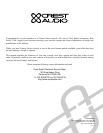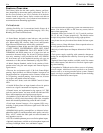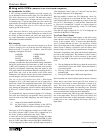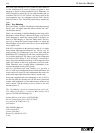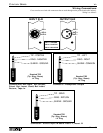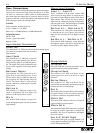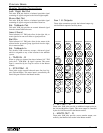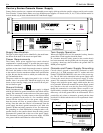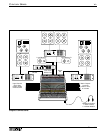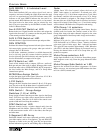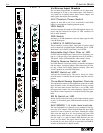
One of the major benefits of VCA’s is that any move made on
a VCA Subgroup will cause all inputs assigned to that
Subgroup to move in direct proportion with it. Inherently, all
effects assigned (or turned up) on any input modules that are
controlled with VCA’s will “follow” any moves made in the
exact proportion also. If a subgroup is moved “3db”; then all
effects will move “3db”. The wet/dry blend always remains the
same.
Wet / Dry Blending
The word “blend”, is used to describe the relationship between
the dry “mix” (all inputs minus the effects) and the wet “mix”
(all the effect returns).
There is no such thing as Wet/Dry Blending when using Audio
Submasters, unless mixing is done on the inputs. Any time an
Audio Subgroup is moved the wet/dry blend is destroyed, as
there is no Mix Integrity or True Post Effect Sends. The only
true way to change the wet/dry blend would be to adjust the
Master Output on any effect send. This is also an undesirable
way to adjust a mix.
With VCA’s assigned as in the previous example, it is a simple
task to adjust the balance between the ‘dry’ and the ‘wet’ by
simply moving VCA Subgroup 6. Any moves made with the
Band Master VCA (Subgroup 8) will cause everything will fol-
low in direct proportion. The same is true for the background
vocal mix (on VCA Group 7). If VCA Group 7 is moved up or
down, all reverbs and delays turned up on all background vocal
inputs will remain in the exact proportion you have estab-
lished. Therefore, once a wet/dry blend is established, it can
never be changed by moving VCA groups.
Now it is possible to mix with 4 faders, or if you will, 4
VCA’s: Lead Vocal, Background Vocals, Band and Effects. Of
course, there will always be small adjustments that need to be
made on the input faders from time to time to tweak a mix.
It has been suggested that when attempting to mix on VCA’s
for the first time, the operator turn off the sound system and
monitor with headphones. All the subtle nuances achieved can
then be heard, and the ability to easily control a mix will
become obvious. C
This “VCA Mixing” section was adapted from an article enti-
tled “Mixing with VCA's,” written by Mark Smith, which
appeared in LIVE SOUND! Magazine.
Anthony McLean is the editor of LIVE SOUND!
You can contact him by Fax at (913) 677.6621,
by e-mail at CIS 75300,3141 or by
snail-mail at:
LIVE SOUND! Magazine
4741 Central #222
Country Club Plaza
Kansas City, MO 64412-1533
U.S.A.
VX
PAGE 4
CENTURY SERIES




